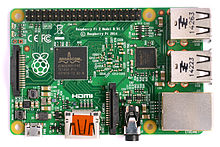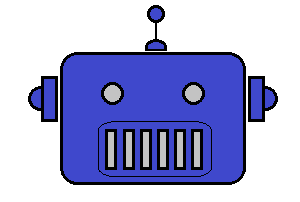Choosing the right computer board
Recently, the field of robotics became incredibly popular and the robotic community is growing larger every day. This growth is mainly caused by latest appearance of cheap and easy-to-use computer boards as Arduino or Raspberry Pi on the market.
The easiness and simpleness of the last two projects allows even children to access the amazing world of robotics and construct a robot on their own. We will introduce the two projects in more detail, since the robot's capabilities and possibilities depend on the choice of a good and adequate microprocessor.
Raspberry Pi

The Raspberry Pi computer can be a little challenging at the beginning, since it is a full-fledged compute(after you plug-in a monitor via HDMI port and a keyboard via USB port) and one has to tackle down the problem of installing an operation system on a SD memory card. Nevertheless, there are shops offering already pre-installed SD memory cards with Raspian (modified Linux distribution of Debian) which allow a really easy start for everyone.
With the system installed it is easy to set the Raspberry Pi to boot directly with Scratch. The Scratch is an intuitive programming language with graphical interface. Instead of writing structured text code you just create, move and plug bubbles representing e.g., cycles, conditions or variables. Thanks to the graphical interface even small children can learn the very basics of programming and write their own simple programs. The power of the Scratch is in its libraries allowing one to access the GPIO ports of the Raspberry Pi and control motors or read off data from various sensors. The Scratch allows also to create programs with an advanced graphical user interface and one can write for example nice graphical games as tetris or pacman. Nevertheless,we have to admit that the Scratch is not the best choice for this purpose, because of its computational demands more complex programs wont run smoothly.
There exist a countless number of devices you can connect and command by Raspberry Pi computer. The mot outstanding module is actually a HD camera module which is easy to use with the computer. Nowadays, there are two camera modules the standard one and the Noir. The standard one captures pictures and video in normal colors, while the Noir version lacks the infra-red filter. This shortcoming influences the colors of the pictures and videos in a rather negative way, but offers the possibility to for the camera module to be used in dark as a night vision.
The camera module and the sufficient computational power of the computer allows to use image processing and robotic vision for in your applications.
Arduino

This project is different to the Raspberry Pi. In this case we are talking about simple programmable boards with processors and not about a self-standing computers. Aduino provides several types of boards suitable for different tasks (e.g., Uno, Extreme and others) In order to programme an Arduino processors you need to have a computer with USB-ports, where you have installed an Arduino environment.
There are also many projects based on the Arduino processors. One of the most outstanding projects is the RFDuino, which combines a small energy saving Arduino based microprocessor with a bluetooth receiver. One of its perk is modular nature of the project where different components can be connected as modules(e.g., as the button shield with three LED diodes or a temperature sensor) to the main processor board while preserving the minimalistic scales.
The overall disadvantage of all Arduino boards are their restriction of computational power(with respect to the Raspberry Pi). Nevertheless, if you need your microprocessor to carry on simpler tasks with nearly no delay, the Arduino as your choice.
The Arduino language is based on C/C++ languages and may be a little challenging if you are not familiar with those languages, but there are many tutorials in the environment itself to start with and many more can be found on the internet.
Conclusion
I planned to construct a compact mobile robot with sufficient computational power to use a camera for different tasks as video streaming or robotic vision. At the beginning I was not sure, which exact tasks I would like my robot to execute, but I wanted to have the highest freedom possible. I also wanted to be able to connect to the robot with my computer and conduct changes in its program.
Therefore, the Raspberry Pi was the proper choice for me.



Share this page with friends via